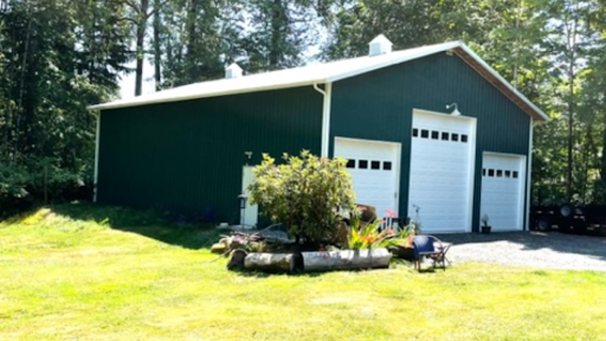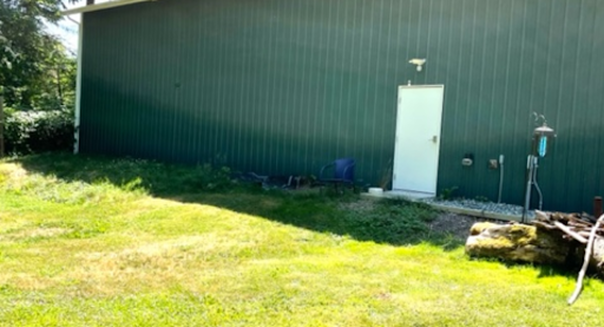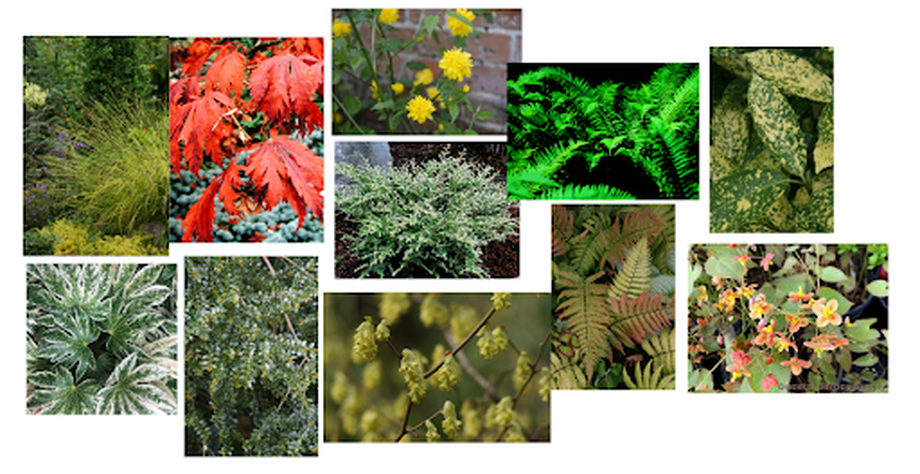Second Garden

<-- Back
The next garden is a blank slate. The first thing you want to do is to create a garden bed. Use some kind of rope that is colored. I use a bright yellow nylon rope. You want to take the rope, place it on the ground, and establish your bed. And what I would do, since there's something existing on the right, I would come out at least as deep as you can on the right.
I don't know how the gardener feels about Rodies, but there's probably a better choice for that area. There would even be room for a smaller tree and would help provide a little more balance to the tall trees on the side of the building. There is probably enough space for even a kidney shaped bed. You're going to take the rope from this corner here and step on it or put a rock on it and just kind of play with the rope. Have it come out and join with the end of the building. You might be able to do a little kidney shade. Then if you wanted to create something that would come out on the side, that would be an option.

The next garden is a blank slate. The first thing you want to do is to create a garden bed. Use some kind of rope that is colored. I use a bright yellow nylon rope. You want to take the rope, place it on the ground, and establish your bed. And what I would do, since there's something existing on the right, I would come out at least as deep as you can on the right.
I don't know how the gardener feels about Rodies, but there's probably a better choice for that area. There would even be room for a smaller tree and would help provide a little more balance to the tall trees on the side of the building. There is probably enough space for even a kidney shaped bed. You're going to take the rope from this corner here and step on it or put a rock on it and just kind of play with the rope. Have it come out and join with the end of the building. You might be able to do a little kidney shade. Then if you wanted to create something that would come out on the side, that would be an option.
I love when I am planting in front of colorful buildings. When you have a green house or a green shed or a blue or a yellow or some color like that, there's so many things you can do with plants. I know a lot of the new construction it's 50 shades of taupe. I love to see different colors and I think that yellow will just be so beautiful.
This is an area that's almost full shade and it's visible from the dining room in the house. So again, you want something that's going to look good year round. We start with the focal point. What's our focal point going to be? Well, one idea would be to have a Full Moon Maple. The Full Moon maples are going to have that chartreuse colored leaf that's really going to pop with that dark green background.It's also going to get this great default color. For eight or nine months out of the year, you've got some really beautiful color going on.

Then bring in some more of the supporting actors. This is a pretty showy evergreen shrub called Aucuba Mr. Goldstrike, and I'm not a huge yellow fan, but this plant just rocks. Full shade, water or don't water, it's just great. And that would really be beautiful in front as kind of a backdrop.
I don’t have time for fussy plants in my garden. I want plants that are really going to perform and just be solid and not be fussy. And so, Kerria is this cane growing shrub that is deer resistant, drought tolerant, that'll take full shade, that doesn't mind the sun. It's a long bloomer too. Sometimes you get a second blossom. I have some planted at the base of a Doug fir, which is like the driest place on earth next to Death Valley. And it just does well, and I haven’t watered it all year. It's incredible. They are Canegrowers and they do get those spreads so you can just kind of chop it off. Chop the straight ones eight or seven inches. Every year cut out the dead and you can cut some of them back so it doesn't hurt. It will take full shade. It doesn't really like sun, but it will take it for some time.
And then bringing in some of these lower positions to fill in this lower story here. Like this Sword Fern. The most underrated plant in the Pacific Northwest. I think they're awesome. It's great texture. They're drought tolerant. It'll take sun, it’ll take shade. What is not to like?
Then this Dryopteris Sunset Fern. This is the same family as the autumn fern. This is a newer variety that has more red in it. And then bring in this Epimedium. That's a great perennial too in that it's evergreen, it blooms, it's drought tolerant andIt'll take shape. Yeah. The blossoms, they're like little bearded hats. That's the combination of the flowers. But you have to get out if you want to see the flowers. You have to cut them back in late winter or early spring so you can actually see the flowers.What happens is the flowers come up when you cut all the foliage out, the flowers come up. You can see them with a huge bouquet. That's a great choice.
And then Carex Bowles Aurea that is evergreen. This is not as drought tolerant, but it does well in shade. The grass will give you movement in the garden. So everything's so set, you get some movement and it is deer resistant. What I find with deer resistant plants and rabbit resistant plants is that the deer and the rabbit will eat anything, if they're hungry enough. It seems like they're interested when you first put a plant in the ground, they're like. They are thinking “ew…I’m going to chew this down to the numbins.” But if it has some time to grow, they become less interested. They kind of move on to the next thing. It might take a little more time if you have a lot of deer and rabbits in your garden.
Suggested Plants:
- Full Moon Maple
- Aucuba Mr. Goldstrike
- Azara
- Epimedium Orange Queen
- Carex Bowles Aurea
- Gentch White Hemlock
- Kerria
- Corylopsis Pauciflora
- Spider’s Web Fatsia
- Sunset Fern
- Sword Fern
